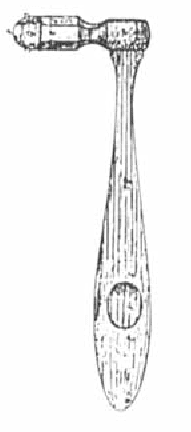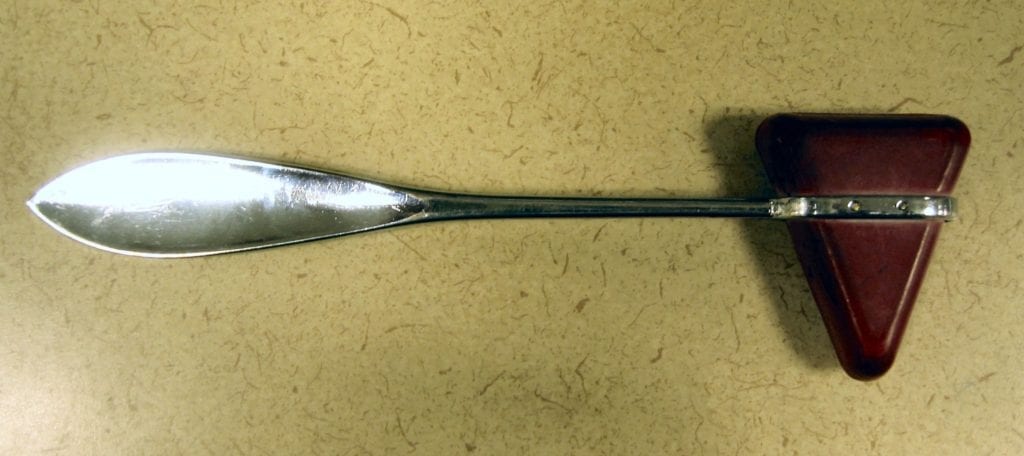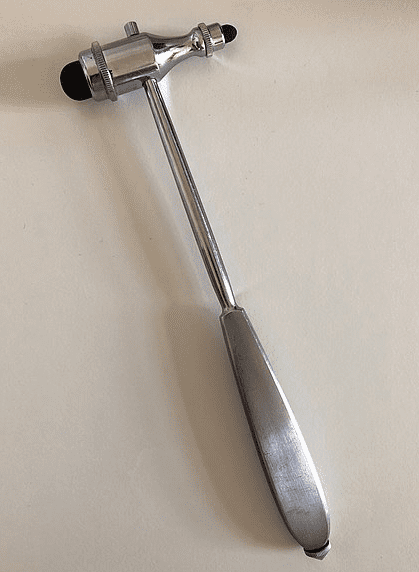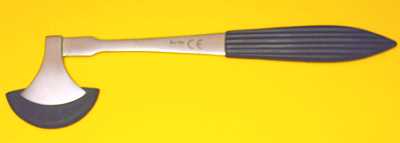JMS Pearce
East York, England
 |
| Fig 1. Wintrich hammer cropped from Semantics Scholars |
The vogue for reflex hammers started with Erb and Westphal’s adjacent papers1,2 in the 1875 issue of the Archiv für Psychiatrie und Nervenkrankheiten, which described the tendon or muscle stretch reflex.
Wilhelm Heinrich Erb (1840-1921) read medicine at Heidelberg where he remained for most of his life. The leading neurologist in Germany, he was compared to Charcot in France, and Gowers in England. He founded the Deutsche Zeitschrift für Nervenheilkunde in 1891. Amongst his successful trainees were Emil Kraepelin, Ernst Julius Remak, Max Nonne, and Paul Julius Möbius.
Carl Friedrich Otto Westphal (1833-1890) was a neuropsychiatrist from Berlin, son of Otto Carl Friedrich Westphal (1800-1879), a physician and ophthalmologist, and Clara, the niece of composer Felix Mendelssohn Bartholdy. Westphal made many contributions and is remembered eponymously for the Edinger-Westphal nucleus, part of the oculomotor nuclear complex. Westphal founded Archiv für Psychiatrie und Nervenkrankheiten. He trained Arnold Pick, Hermann Oppenheim, and Carl Wernicke.
Their descriptions of the knee reflex were similar. Erb described:
Each tap is followed by a contraction of the quadriceps, immediate like lightning, unmistakable, visible, palpable, and apparently reflex: manifestly and often quite strongly is the shank set in motion. It is extraordinarily difficult to suppress this reflex by a voluntary effort . . .
Both used their fingers or percussion hammers to tap the patella ligament. Whereas Erb believed the knee jerk was a simple reflex from excitation of sensory nerves within the tendon, Westphal thought it resulted from local excitation of the quadriceps muscle.
The beginnings of percussion
Before Erb and Westphal a variety of percussors and pleximeters had been used for percussion of the chest, abdomen, and skull; practices deriving from Leopold Auenbrugger (1722-1809), who tapped his fingers on wine casks to elicit a dull thud or hollow sound to gauge the fluid level, and hence how much wine was left.3 He applied this principle to the chest and his Inventum Novum ex Percussione Thoracis Humani was published in 1761.
The Parisian Pierre Adolphe Piorry (1794-1879) in 1826 invented le plessimétre to evoke a resonant or dull sound that helped to outline the internal organs (l’organographisme). He was also responsible for the terms toxin, toxemia, and septicemia. Joseph Skoda (1805-1881) in Vienna minutely analyzed breath sounds and four types of resonance on percussion in his Abhandlung uber Perkussion und Auskultation (1839). Sir David Barry (1781-1836) devised a percussion hammer in 1828—an ebony rod ending in an olive made of gold-beater’s skin and covered with leather—and Max Wintrich in 1841 popularized his own percussion hammer (Fig 1).
Percussion of the chest complimented auscultation using the stethoscope invented and named by René Laënnec (1781-1826). His paper in 1819 was titled De l’Auscultation Médiate ou Traité du Diagnostic des Maladies des Poumons et du Coeur. At first ignored, the pioneer cardiologist Jean-Nicolas Corvisart (1755-1821), Napoleon’s physician,4 and Joseph Skoda reintroduced percussion.
 |
| Fig 2. Taylor hammer. Photo by Samir. Via Wikimedia. CC BY-SA 3.0 |
Tendon reflex hammers
Over many years many percussion hammers were developed and modified.5,6 Originally there were two percussion instruments: a hammer and a resonator called the pleximeter. They were used to detect abnormalities of gas and fluids in both thorax and abdomen. Charcot recommended the Skoda rubber-ended hammer (devised c.1840) for obtaining the knee-jerk reflex. Both Babinski and Berliner advocated the use of a percussion hammer in preference to the hand, stethoscope edge, or a paperweight. Weight and size were important issues in design. Various devices to test sensation were incorporated. After the hammers of Sir David Barry and Max Wintrich (Fig 1), John Madison Taylor’s (1855-1931) in 1888 was probably the first. Many others succeeded it.
 |
| Fig 3. Troemner hammer. Photo by Polarlys. Via Wikimedia. CC BY-SA 4.0 |
The Taylor hammer (Fig 2)
In 1888, John Madison Taylor (1855-1931) of Philadelphia designed a new hammer weighing 60-70 grams. Subsequently, hammers were heavier with longer handles, which were thought to improve efficiency.
Taylor practiced neurology and physical medicine in Philadelphia. He described his “tomahawk” hammer at the February 1888 meeting of the Philadelphia Neurological Society:
. . . In shape it is a cone flattened on the opposite side with apex and base carefully beveled or rounded of about the thickness throughout of the human index finger. The material is moderately soft rubber . . . The special feature of this hammer is that the shape of the striking surface is like the outer surface of the extended hand palm downward, which is most often used in obtaining tendon jerk. The rounded apex is adopted to reach the biceps tendon at the bend of the arm . . . This little tool will also well serve to elicit chest sounds, to percuss the abdomen, . . . being of soft rubber the blow does not hurt.
The Krauss hammer
William Christopher Krauss (1863-1909) practiced neurology in Buffalo, New York. He exhibited his hammer at the American Neurological Association in Washington in 1894. It was a tool that he used for testing reflexes as well as thermal and pain sensibility. Displaying little modesty, he said:
The hammer is constructed after the French pattern having a heavy metallic head fixed to a flattened oval handle seventeen centimeters long . . . The handle (a) being of hard rubber becomes warm on friction while the head being of metal remains cold thus offering the means of examining the sense of heat and the sense of cold fulfilling the requirements of a thermo-aesthesiometer. The cap (c) when removed discloses a triangular spear head about one-half centimeter long while at the other end of the hammer head is the rounded rubber point—the two ends furnishing therefore a sharp and a dull point for examining for anesthesia or hyperesthesia. . . . This arrangement furnishes an excellent aesthesiometer and is as accurate and convenient as any on the market. . . . Removing the cap (e) a camel’s hairbrush is exposed giving a soft surface while the metallic cap (c) gives a hard surface. The hammer . . . has served me with much satisfaction.
 |
| Fig 4. Berliner hammer |
The Troemner hammer
Ernst L.O. Troemner (1868-1930) was director of the Neurological Hospital in Hamburg. He developed a reflex hammer similar to the Krauss hammer in 1910. It was used in Germany and in the United States. Troemner described:
The hammer which is all metal weighs approximately 100 grams is 22 centimeters long lies comfortable in the hand and has a head of 8 centimeters width with knobs of rubber at both ends which can be easily exchanged. The large head is designed for use on the large tendons of the extensor surfaces (patellar, Achilles, and triceps reflexes) . . . The smaller head is used for percussion of flexor tendons (biceps humeri, biceps femoris, and semi-tendinosus). . . . The smooth handle . . . in addition elicits cutaneous and vascular reflexes . . .
Henry W. Woltman (1889-1964), associate professor at the Mayo Clinic, bought several Troemner hammers for himself and colleagues. They became the standard tool at the Mayo Clinic and were given to distinguished visiting neurologists.
 |
| Fig 5. Queen Square hammer. Photo by Samir. Via Wikimedia. CC BY-SA 3.0. |
The Berliner-Babinski-Rabiner hammer (Fig 4)
Bernhard Berliner was a German neurologist who described his modification in 1910:
I constructed a hammer [which has a sufficiently heavy head and a large striking surface] and which in every case proved more useful and comfortable for the testing of tendon reflexes than the common percussion hammers. . . . The device has the shape of a hatchet and an edge covered with rubber which always strikes the tendon along its total width. . . . It is made of metal and nickel-plated. The handle is tapered at the end and may be used for testing skin reflexes. . . .
Joseph François Babinski wrote a monograph in 1912 in which he described two reflex hammers, precursors of the Queen Square hammer (Fig 5) but with a metal shaft:
Here I will describe two that are the most frequently used. One of them is composed of a handle of nickel-plated steel which is 20-25 cm long and fixed at the center with a disk which is made of the same substance and which has at its circumference a furrow filled with a ring of rubber. In the second type which more easily fits into a pocket . . . the disk is replaced with a rubber ring in its peripheral canal.
In 1920 Babinski met an American, Abraham Rabiner. After settling an argument about the mechanism of the Babinski plantar reflex, Babinski gave Rabiner his own reflex hammer, which Rabiner modified with a circular rotating hinged disk that could be aligned parallel or perpendicular to the handle.
The Queen Square (Vernon or Wintle) hammer (Fig 5)
Henry Vernon of the Great Northern Hospital in 1858 devised a reflex hammer with a handle of whalebone eight inches (20cm.) in length with a grooved spherical metal head carrying a rubber striking ring. It was adapted by physicians at Queen Square. Miss Wintle, the nurse in charge of physiotherapy and radiology, in about 1925 made them herself and sold them for two shillings and six pence (12 pence in today’s currency) to doctors. The bamboo cane was flexible, eight inches long. The shaft’s end was pointed for eliciting plantar and abdominal cutaneous reflexes.
Eliciting tendon reflexes remains a vital part of a patient’s neurological examination for which purpose tendon hammers remain indispensable. Many are still available (Fig 6), some with devices incorporated to test sensory modalities. The Vernon Queen Square hammer is in routine use by British and many other neurologists, though an anemic-looking, plastic handle has replaced the bamboo or wooden cane.
 |
| Fig 6. Some reflex hammers |
Read more on the origin of the knee jerk reflex.
References
- Erb WH. Uber Sehnenreflexe bei Gesunden und bei Ruckenmarkskranken. Arch Psychiat Nervenkr 1875;5:792-802.
- Westphal CF. Uber einige durch mechanische Einwirkung auf Sehnen und Muskeln hervogebrachte Bewegungs-Erscheinungen. Arch Psychiatry Nervenkr 1875;5:803-34.
- Dunea G. Percussion of the chest: Leopold Auenbrugger. Hektoen Int, Summer 2018.
- Liebson PR. René Théophile Hyacinthe Laënnec and the stethoscope. Hektoen Int, Spring 2013
- Schiller F. The reflex hammer. In memoriam Robert Wartenberg (1887-1956). Med Hist. 1967;11(1):75-85. doi:10.1017/s0025727300011753
- Wartenberg, R. The Examination of Reflexes, a Simplification. Chicago, Year book publishers, 1945.
JMS PEARCE, MD, FRCP, is a retired neurologist and author with a particular interest in the history of science and medicine.

Leave a Reply